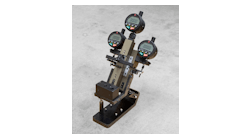Corporate jet operators outsource to MROs; MROs outsource to subcontractors. And down the food chain it goes — each layer adding to, and benefiting from, the architecture of it all. In an increasing number of cases, there’s yet a third tier: Jet Support Services Incorporated.
JSSI is an hourly cost maintenance provider, one whose aim is pretty straightforward: to “eliminate your risk [while] enhancing the residual value of the aircraft,” says Raymond Weiser, a helicopter program specialist with the privately owned Chicago-based company.
While declining to provide specific numbers, JSSI says “2016 was the strongest sales year in JSSI’s 28-year history.” Specializing in corporate aircraft — both fixed wing and rotary — it spends north of a half billion U.S. dollars each year on maintenance on behalf of some 2,000 clients worldwide — all without ever turning a wrench itself. Instead, “We have a vendor network,” says Weiser. “Our vendors are the ones who provide the work for us. We’re a financial tool,” he asserts. “Our vendor network is extensive. Matter of fact, there’s a line of vendors waiting to come on board to become part of the JSSI network.”
That network is bizjet and helicopter powerplant heavy. The company says there are some 350 different JSSI powerplant programs just now, programs covering virtually all types of turbine engines. Among the players represented: GE, P&WC, Rolls-Royce, CFM, Honeywell, and Safran/Turbomecca. Jet Support Services Incorporated says it manages 250 to 300 overhauls each year.
Close Scrutiny
‘Manage’ is operant word here, close-in, eyes wide open oversight. “We represent [our clients] in times of major events,” says Weiser. “We’ll travel to the OEM. We’re basically an extension of [our client’s] maintenance department. We’ll inspect their engine … essentially providing a check and balance throughout the MRO process.”
Boots on the hangar floor are provided by experts who know the terrain intimately, product line specialists. “For each engine product line there’s a product line specialist. “We’re not taking a Rolls-Royce guy and [assigning him to] a Pratt & Whitney-type event,” says Weiser. At JSSI, the inspector understands the sometimes-subtle twists and turns of the powerplant whose overhaul he’s overseeing and understands them well.
Re-wind time for a moment here and understand how it all fits in the bigger picture. “On any given day,” says Weiser, “your director of maintenance is responsible for helicopters, for airplanes, for employees ordering parts.
“He doesn’t have time to specialize,” asserts Weiser,” an ex-maintenance director himself. He may have sat in on an overhaul once every five or six years. By contrast, a JSSI product line specialist can expect to see perhaps two dozen per year.”
New on the Horizon
Complementing JSSI’s philosophy is its new Asset Monitoring Platform 2.0. The company says AMP 2.0 “has a new feature set which enables subscribers to access a variety of tools for managing an aircraft’s financial and maintenance status, even if the aircraft is not enrolled in a JSSI program.”
Among the more relevant features are:
• A maintenance rating tool;
• A “Request for Tech Inspection” Service;
• A “Request a Tech Oversight” Service;
• JSSI Parts Ordering;
• Intuitive Navigating and Reporting;
• A High-Level Fleet Maintenance Forecast covering major events.
JSSI President and CEO Neil Book calls AMP 2.0 a platform for allowing finance and leasing companies to leverage the technology to provide enhanced visibility into their aviation portfolio on a real-time basis. “Over the coming months” watch for the company to introduce a range of new services which Book contends will “drive additional value not only to our customers, but the [business aviation] marketplace at large.”
Independence?
The emergence of JSSI as a major player on the MRO stage underscores a growing trend toward independent sourcing on the part of operators, fixed wing and rotary alike. After 35 years in this business, that’s certainly Ray Weiser’s assessment. “In the past, if you had certain aircraft, the only place you could go [for maintenance, repair and overhaul] would be the OEM. In the past, they were the only option you could go to.”
That was some 28 years ago, an era in which the options for MRO were — compared to today — limited. JSSI “initially started by overseeing the upkeep of Garrett 731s, a popular powerplant for corporate jets. “We then went into other jets: turbofans, propjets.”
Helicopters
Recent years have seen JSSI expand into the world of rotary wing maintenance oversight.
In the world of wings that go round-n’-round maintenance intervals have often been shorter, and tolerances for parts and components lower compared to their fixed-wing brethren. Weiser says this is especially true for “newer model helicopters that may have come out in the last three years. Their tolerances are tighter.” The JSSI rotary wing specialist says a couple of reasons underlie this trend. “Clients want to look at their product as soon as possible to see how it’s holding up” under the often unrelenting rigors of helicopter operations.
Then there’s this: “Helicopters tend to be more labor-intensive, far more labor intensive, than fixed-wing aircraft. They are inherently so."
Precisely because of the sometimes-higher costs attached to rotary-wing MRO this is an arena in which JSSI tends to shine.
Take the case of an overseas helicopter operator who asked that AMT not use their name. Weiser says, “The OEM wanted to give the client an exchange module, part of the engine really. Essentially, the client had a cracked flame tube … The answer to that was, ‘Well, let’s have an exchange for US$170,000. We’ll take your module in exchange and we’ll give you one for $170,000, plus potential bill backs.
“[JSSI] looked at that the work scope [and discovered] it was a simple repair that gets done in a specialized [Level 3] facility. That repair runs about $US40,000 to $45,000.
Weiser ended up dealing directly with the client. "We talked about it. He said, ‘If you can repair my engine for $45,000 vs. $170,000 you’ve got my business. So we managed the event for the client. We sent it to a Level 3 facility. The repair was done as we said [it would be]. He had it back in his hands within a couple of weeks.”
This deal paved the way for a substantial future contract for a specified number of aircraft.
“This is where we shine,” says Weiser. Indeed, “there’s nothing more critical than when your engine goes into the shop,” he says. Overhauls can run a half-million U.S. dollars at a crack.
An important tool
Again, JSSI is neither an MRO, a parts supermarket nor a middleman. Its services are best described as “tool[s] to help contain costs … The more we can drive our client’s costs down, the greater the trust.”
Here’s the kicker. Weiser says, “When we save a client money, the money goes back to the client. We’re very transparent in how we do things.” JSSI derives those discounts because of the volume of work it oversees.
Transparency and trust are commodities in short supply these days. The concepts are touchstones at the company. Consider, Weiser contends JSSI “is the only one in the industry to utilize a trust to safeguard the client’s money.” The protection clicks in in case something happens to the company.
Competitive cost, quality work, knowledgeable oversight transparenc,y and trust: Essential ingredients in an uncertain age.




